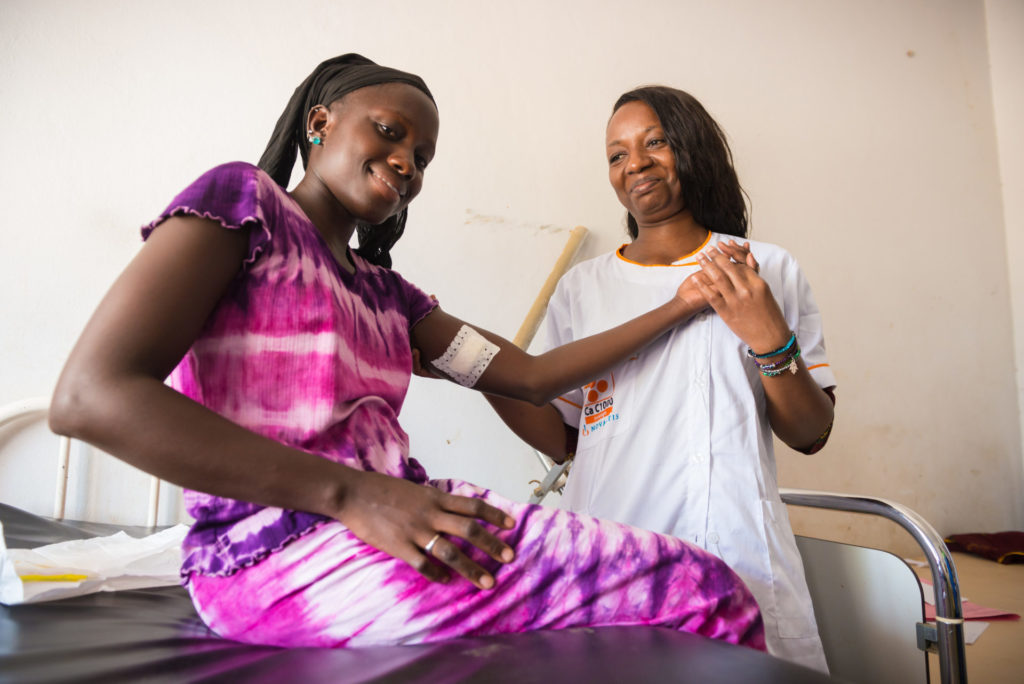We Know What Works, So Let's Do It: Support Voluntary Family Planning
Written by Pape Amadou Gaye, President Emeritus, IntraHealth International | Published: August 31, 2020

I grew up in Senegal, a country in the Sahel region in West Africa. Senegal is what we in the global health community might call “pronatalist,” meaning that people prefer large families and tend to use contraception for spacing, rather than limiting births. Contraception was, and often still is, difficult to come by, and many women die as a result of childbirth complications. Even more often, their newborns die.
According to the World Bank, women in Senegal have a 1 in 65 lifetime risk of dying from pregnancy-related causes, with the figure even more dire for poor women. For every instance of maternal mortality, there are 20 instances of serious morbidity (e.g. obstetric fistula, anemia, uterine prolapse). Women increasingly want and use contraception, but many still cannot access it—one in four Senegalese women has an unmet need for contraception. If all unmet need were met, maternal mortality would be reduced by 30 percent. Yet, with the COVID-19 pandemic, access to health services has become even more challenging.
After over 30 years working in global health and development, including 15 years leading IntraHealth International, a U.S. organization with programs in 44 countries, I have become convinced that family planning remains one of the most critical development activities for the well-being of people—and the planet. My passion for and commitment to family planning grew even stronger because of its double benefit: Family planning improves the health of women and children while at the same time contributing to the long-term sustainability of development programs. And there is arguably no more cost-effective intervention for the environment than increased access to voluntary family planning.
Access to modern contraception has become a widely recognized human right and, increasingly, across the globe, contraceptive use has become an informed individual choice. Yet data regarding world population growth seem to suggest that international family planning programs have not performed as well as they could have. After all, when the birth control pill was approved by the U.S. Food and Drug Administration in 1960, the world’s population was 3 billion. On the first World Population Day in 1989, it had just crossed 5 billion. Now, in 2020, it has climbed to 7.8 billion, and is projected to rise to 9.7 billion in 2050 and 10.9 billion in 2100.
But consider this: In 1965, when the United States Agency for International Development (USAID) established its Office of Population, only 9 percent of married women in low- and middle-income regions used modern contraception. These women had more than six children on average. In 2019, 24 percent of women in low-income countries used modern contraception, and they had an average of 4.4 children each. In middle-income countries in 2019, 45 percent of women used modern contraception, and they had an average of 2.3 children each—not much higher than replacement rate!
Recent developments only ensure that progress continues (assuming adequate funding). Renewed global leadership catalyzed by the FP2020 movement, the development of new contraceptive technologies such as the self-injectable Sayana Press, robust involvement of the private sector, and new players such as social entrepreneurs have all contributed to creating new momentum. I am encouraged by high-impact service delivery practices such as community-based provision of methods, contraceptive social marketing, and task sharing by lower-level health professionals and lay workers. In addition, the increasing availability of digital solutions for training and information sharing is allowing countries to achieve faster, more sustainable progress in their family planning programs.
I am also very encouraged by recent progress coming out of the Ouagadougou Partnership, a coalition of government officials, religious leaders, civil society members, and youth representatives from nine francophone West African countries—Benin, Burkina Faso, Côte d’Ivoire, Guinea, Mali, Mauritania, Niger, Senegal, and Togo—working in collaboration with donors to improve family planning outcomes in the region. During 2011–2020, the Partnership doubled the number of new users of modern contraceptive methods by adding 3.8 million users in the region.
Further, nongovernmental organizations like IntraHealth International have continued to advocate for investments in family planning as essential for human and economic development. And the message is resonating. High contraceptive access and use in rapidly developing middle-income countries continues to be a “virtuous circle,” helping generate their economic growth and development, which in turn has fueled increasing adoption of contraception. And global megatrends such as rapid urbanization, women’s greater education and empowerment, and the spread of social media are continuing to drive a desire for smaller families and greater adoption and use of modern contraceptive methods by women of all ages, family size, income levels, and place of residence. In turn, this has enabled greater investment per child, and greater women’s health and family well-being.
Demographic Dividend
The fiscal benefits for countries with robust family planning programs are huge. As more people than ever make the transition from large families and short lives to smaller families and longer lives, we’re reminded that health, family size, and prosperity are irrevocably intertwined.
Part of this is due to a phenomenon called the demographic dividend, and this is how it works: After a period of lowering fertility in a population (such as when modern contraceptives enter the picture, and women and families begin choosing to have fewer children), there is a window of opportunity during which the number of working-age adults grows faster than the number of nonworking-age people who depend upon them. If a country has properly planned (for instance, by making sure there are enough jobs available for these working-age adults), it can take advantage of this window by growing its economy, freeing up resources, and using them to meet other pressing needs.
Look at what the Asian tiger economies have accomplished by creating a demographic dividend through strong, voluntary family planning programs. Indonesia, Thailand, and Singapore, for example, have created favorable policy environments, relaxed the laws that were holding their programs back, and invested greatly in their community health workforces. Thailand has essentially destigmatized family planning and made it a mainstream way of life. Many of these countries put line items in their budgets to buy contraceptives—that is domestic investment.
While countries are currently focused on the COVID-19 pandemic, they are also paying greater attention to strengthening their health care systems. This is a good time to start emphasizing the many benefits of leveraging the demographic dividend so that more countries can enjoy the health and fiscal benefits of family planning. This is a moment of rare opportunity because many low-income countries are economically poised to become middle-income countries. The African continent, for instance, has been the fastest-growing economy in the world. Countries that have long fallen behind are now ready to hear an economic argument for family planning.
Family Planning as an Investment
Family planning and slower population growth have a positive impact on nearly all 17 of the United Nations Sustainable Development Goals (SDGs):
- No poverty
- Zero hunger
- Good health and well-being
- Quality education
- Gender equality
- Clean water and sanitation
- Affordable and clean energy
- Decent work and economic growth
- Industry, innovation, and infrastructure
- Reduced inequalities
- Sustainable cities and communities
- Responsible consumption and production
- Climate action
- Life below water
- Life on land
- Peace, justice, and strong institutions
- Partnerships for the goals
The international family planning community knows “what works.” Political will and adequate financial and human resources to enable wider provision of family planning services have been lacking, however. More than 218 million women want to prevent pregnancy, but have an unmet need for modern contraceptives. And the poorer they are, the less likely they are to have access to them. This has a devastating generational ripple effect, which keeps the cycle of poverty going. On the other hand, women who have access to contraceptives tend to be healthier, get more education, and have a better shot at earning wages. And so do their children.
In the U.S., the broad bipartisan support for population assistance that once existed in Congress has fallen away in the face of abortion politics and partisan political rancor. This change has taken place despite longstanding prohibitions on U.S. financial support for abortion services, and the fact that abortion almost always represents, in some sense, “failed family planning.”
Action Needed
If you are concerned about climate change, support voluntary family planning programs. If it bothers you that 10 percent of the global population live in extreme poverty on less than $1.90 per day, support voluntary family planning programs. If you oppose abortion or want to reduce it, support voluntary family planning programs. If you are worried about political instability, support voluntary family planning programs. If unconscionably high maternal mortality in low-income countries disturbs you, support voluntary family planning.
Let Congress know that voluntary family planning programs should be a global health and development priority and that the U.S. should fund them fully. It’s the highest-impact, most cost-effective investment we can make.

